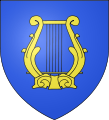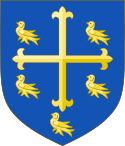Heraldyka fantazyjna
| Ten artykuł od 2022-03 wymaga zweryfikowania podanych informacji. |
Heraldyka fantazyjna jest działem heraldyki zajmującym się fantazyjnymi herbami przypisanymi istotom nieludzkim oraz realnym osobom żyjącym w czasach przedheraldycznych, które zajmują szczególne miejsce w historii i kulturze ludzkości.
Francuski historyk Michel Pastoureau zaproponował podział heraldyki fantazyjnej na kategorie:
- Rzeczywiście żyjące osobistości antyczne oraz średniowieczne, szczególnie władców. Np. herb przypisany Edwardowi Wyznawcy.
- Herosi i bogowie greckiej i rzymskiej mitologii, jak np. herb przypisany Priamowi.
- Herosi i bogowie skandynawskiej i germańskiej mitologii, jak np. herby przypisane Odynowi lub Thorowi.
- Rzeczywiste oraz nierzeczywiste osobistości spoza europejskiego kręgu kulturowego. Są to np. herby przypisane sułtanom, cesarzom Konstantynopola albo Chin, Attyli itp.
- Postacie biblijne, np. herby przypisane Adamowi i Ewie, Jezusowi, prorokom, apostołom, Szatanowi itp.
- Inne postacie chrześcijaństwa, np. herby przypisane Trójcy Świętej, świętym, itp.
- Osoby, królestwa i miejsca powstałe jako wytwory wyobraźni, np. herb przypisany księdzu Janowi.
- Bohaterowie literaccy. Tu jako przykład herb przypisany królowi Arturowi.
- Różne alegoryczne personifikacje, jak np. herb przypisany śmierci.
Galeria herbów przypisanych
królowi Dawidowi
Media użyte na tej stronie
Autor: AnonMoos, Licencja: CC BY-SA 3.0
The coat of arms traditionally attributed to Satan in European heraldry. Blazoned "Gules, a fess Or between three frogs proper" (or with effectively equivalent blazons, such as "Gules, a fess Or between three frogs Vert", "Gules, a fess Gold between three frogs proper", etc.).
In the book The Heraldic Imagination by Rodney Dennys (1975), this is traced back to the late 13th-century Douce Apocalypse manuscript, in an illustration to Revelations 20:7-10. The design is based on the "three unclean spirits like frogs" of verse 16:13.Autor: originally Ssire, modified by AnonMoos, Licencja: CC BY-SA 3.0
The coat of arms of heraldry itself, according to one fanciful tradition. Note that this technically violates the heraldic "rule of tincture" (but no more so than the traditional arms of the crusader kingdom of Jerusalem).
Autor: Autor nie został podany w rozpoznawalny automatycznie sposób. Założono, że to Ssire (w oparciu o szablon praw autorskich)., Licencja: CC BY-SA 3.0
- d'azur à deux lions passant d'or.
Banner of the mythical Prester John in the 14th century anonymous "Libro del Conoscimiento de todos reynos".
The coat of arms with the skull
Autor: Autor nie został podany w rozpoznawalny automatycznie sposób. Założono, że to Ssire (w oparciu o szablon praw autorskich)., Licencja: CC BY-SA 3.0
Azure a lyre Or
Coat of arms attributed to St. Michael the archangel in the heraldry of medieval England, as seen in the coat of arms of Sunderland, etc. Blazon: Argent, a cross pommy gules.
An alternative depiction is to show Michael bearing a shield with "QUIS UT DEUS" (the Latin translation of Hebrew mi-ka-el מי־כאל), or "Who is like unto God?" (see Image:StMichaelAtCathedralCologne.jpg, Image:Michael4.jpg, Image:Michaelseiche bei Albertshausen, 5.jpg, etc.). For another medieval attributed arms of St. Michael, see File:Harleian Ms2169 St Mihell arms tricked original.gif.Autor: Montage graphique : --Ssire (talk), Licencja: CC BY-SA 3.0
One of several attributed arms for King Arthur
Autor: Sodacan, Licencja: CC BY-SA 3.0
Attributed royal Coat of arms of King Edward the Confessor (who lived before standardized coats of arms came into use) by Matthew Paris, based on a design on Edward's coinage. Edward's arms were impaled or quartered by his descendants. Blazon: Azure a cross flory between five martlets Or.



















